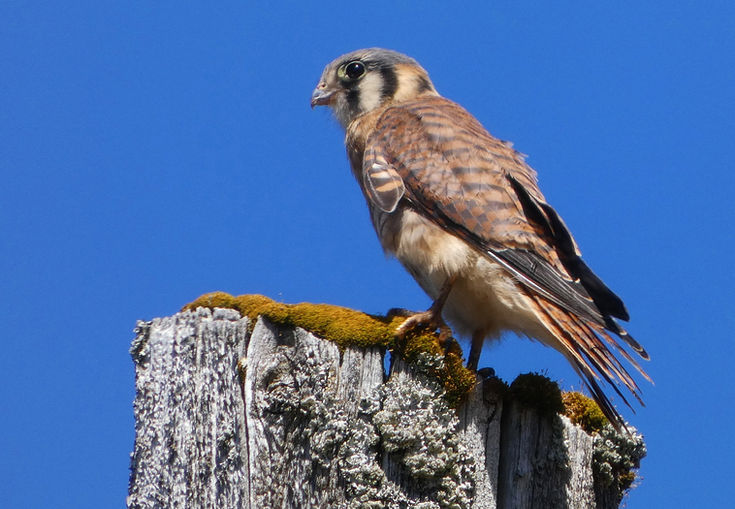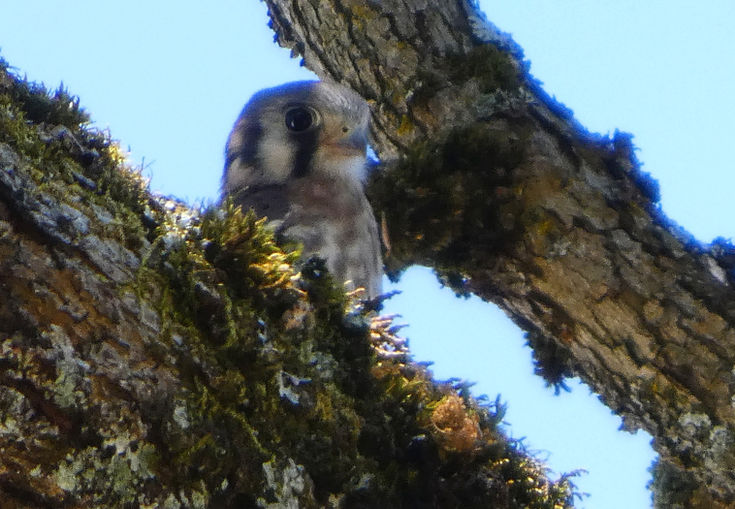Photos, Videos, Podcasts
The branch fell on the dirt, not on the roadway
5/16/2023 photos by Eldon Newell, City of Tumwater (via public records request)



Fledglings from the oak tree's nest cavity (6/30/2025)
Photos by Lisa Genuit
Air Excavation of Roots (12/13/2024)

2024-12-13 Root air excavation
Using an air excavator, Arborists from Todd Prager & Associates remove fill dirt piled onto the roots decades ago. They are checking for fungal pathogens as part of the second risk assessment. Photo credit: Tanya Nozawa.

Using an air excavator, arborists from Todd Prager & Associates remove fill dirt piled onto the roots decades ago. They removed the dirt to check for fungal pathogens as part of the second risk assessment. Video credit: Tanya Nozawa.
Mayor Orders Staff to Pull Up Baby Oaks After Citizens Ask Them to Be Preserved (11/25/2024)

Garry oak seedling growing at the base of the Davis Meeker oak. Photo credit: Tanya Nozawa, September 27, 2024.

Garry oak seedlings growing at the base of the Davis Meeker oak. Photo credit: Pam Hanson, July 17, 2024.

Place where the mayor's employee pulled up the oak seedling on November 25, 2024, shortly after we notified the city council of its existence and asked it to be preserved. Photo credit: Tanya Nozawa, December 1, 2024.

Place where the mayor's employee pulled up the oak seedlings on November 25, 2024, shortly after we notified the city council of their existence and asked them to be preserved. Photo credit: Ronda Larson Kramer, December 9, 2024.
First Annual Cowlitz Trail Walk (10/27/2024)

Participants gather at the Davis Meeker oak before walking 2.7 miles to the Squalli-absch Family Forest along the path of the Cowlitz Trail/Oregon Trail. Photo credit: Kathy Cox.

2024-10-27 Cowlitz Trail walk
Participants of the walk enjoy a fire and sandwiches at the Squalli-absch Family Forest after walking from the Davis Meeker oak 2.7 miles along the path of the Cowlitz Trail/Oregon Trail. Video credit: Ronda Larson Kramer.

Ronda Larson Kramer, Brette Clubbe, Greg LaDue-Grove, and Ray Gleason at the Cowlitz Trail/Oregon Trail crossing in the Squalli-absch Family Forest. Photo credit: Ronda Larson Kramer.

Route of the walk on the historic Cowlitz Trail, starting at the Davis Meeker oak and ending where the trail crosses the Squalli-absch Family Forest off Sheldon Road and 93rd Ave SE, Olympia.
Radio Interview with Oak Tree Litigation Update for Last 15 Minutes (9/12/2024)
Podcast from KAOS Parallel University featuring an oak tree litigation update (the last 15 minutes of the interview) and a discussion of a recent change in state land use laws that could result in the paving over of one of the last remaining remnants of the Cowlitz Trail, which is on forestland a mile south of the oak tree. The interviewees are Ronda Larson Kramer and Marianne Tompkins.
Radio Interview on the Cowlitz Trail and the Davis Meeker Oak (9/22/2024)
September 22, 2024, KAOS Podcast-Make No Bones About It, about Native American history and the Cowlitz Trail and Davis Meeker oak, featuring Ronda Larson Kramer, Cowlitz Tribe historian Mike Iyall, Michelle Peterson, and Cowlitz Tribe elder Greg LaDue-Grove.

Photo credit: Brian Frisina

2024-09-08 Casey Neill
Radio Interview on the Fight to Save the Davis Meeker Oak (6/27/2024)
Podcast from KAOS Parallel University gong in-depth on the exciting last-minute save of the tree. The interviewees are Ronda Larson Kramer, Michelle Peterson, and Beowulf Brower
1984 - The road is moved to save the tree

Spring 1984. Photo by Karen Fraser
In 1984, the county owned the tree. The county road department wanted to make safety improvements to Old Highway 99 and asked the county commissioners for permission to cut down the tree.
Several citizens testified that the tree should be saved. Jack Davis was an eminent leader of environmental issues in the area. He was soft spoken and well-respected. He and others provided public testimony to the county commissioners, one of whom was Karen Fraser (who later became a state senator). She recently spoke to Ronda Larson Kramer and recalled how it came about: "So those of us who live there, we saw that if you cut the tree down, it changes the whole landscape. So we directed the road department to save the tree and do what they could and to put up a safety barrier. It passed unanimously. . . . And Jack Davis had a lot of credibility and everyone respected his perspective." The county then moved the road to give the tree space.
Among those who asked the county to save the tree in 1984 was Scott Baker. He is one of the fathers of the modern risk assessment methodology. He owns Tree Solutions, which is the company that evaluated the tree in 2023 at the request of the Tumwater city arborist. At that time Mr. Baker's employee wrote that the tree had slightly more wood than was needed to support the tree and that if the tree was to be retained, it should be managed as a veteran tree.
But the city arborist's final recommendation contradicted this and recommended that the tree be cut down. Mr. Baker later wrote an email to the city and called the city arborist's own risk assessment an "embarrassment to any knowledgeable arborist."
2024 - See How the Tree Has Grown!

June 28, 2024. Photo by Wayne Shreckengosh.

Photo by Ronelle Funk, January 12, 2019, at 9:32 am.

5/9/2024 Photos from a drone, taken by the City of Tumwater in anticipation of imminent removal.
Old Highway 99 Reroute Plan
by Professor Robert Van Pelt

July 8, 2024. Photo by Robert Van Pelt, of California
How to move the road. Professor Robert Van Pelt, a forest ecologist known as Big Tree Bob, is an artist and global authority on champion trees. He specializes in quantitative ecology at the University of Washington's School of Environmental and Forest Sciences.
Descendants Meet for First Time

August 14, 2024, Photo by Bellamy Pailthorp, KPLU Reporter
Left to Right: Brandon Staff (descendant of pioneers George and Isabella Bush), Ray Gleason (arborist), Ronda Larson Kramer (attorney), Jim Thomas (descendant of pioneer T. J. Harper), David Nicandri (historian and Tumwater Historical Commission member), and dog Gus.
According to family oral history, Brandon Staff's ancestor George Bush told Jim Thomas's ancestor T. J. Harper and Harper's Oregon Trail party (which included Ezra Meeker) to camp under the big tree northwest of Bush's farm. He told the party that the surrounding prairie would provide browse for their livestock and a small lake just to the east would be a convenient place to water the stock. Jim Thomas's family believes that the Davis-Meeker oak, the largest in the area, is the one they camped under. Descendants Brandon and Jim met each other for the first time on August 14, 2024 at the Davis Meeker oak, which most likely was that tree.
Kestrel family that lives at the tree

Photo by wildlife photographer Bruce Livingston, July 16, 2024
Adult female American kestrel leaving the nest cavity. The kestrel family uses the nest cavity year round. On October 11, 2024, when arborists were climbing the tree, the kestrels were flying around making alarm calls.

Photo by wildlife photographer Bruce Livingston, July 16, 2024
Juvenile female and juvenile male begging for food at the nest cavity.

Photo by wildlife photographer Bruce Livingston, July 16, 2024
Juvenile begging for food.

Kestrel young ready to fledge
Three young ready to fledge, receiving grasshoppers from Dad.
July 10 2024. Video by Melinda Wood of Olympia

July 10, 2024. Photos by Melinda Wood of Olympia




Young kestrel exercising his wings
One of the three young kestrels exercising his wings.
July 10, 2024. Video by Melinda Wood of Olympia

The three young kestrels begging for food from their parents.
July 10, 2024. Photo by Melinda Wood of Olympia
Kestrel Nesting Behavior
Kestrels often reuse the same nest site every year, and their offspring can continue to use that same nest site down through the generations. Also, kestrels will use their nesting cavities as roosting sites outside of the breeding season. "American Kestrels are secondary cavity nesters that nest in existing natural and man-made cavities. The species prefers nest sites that are surrounded by suitable hunting grounds and that have unobstructed entrances. In some areas, the lack of available nest cavities limits the number of breeding pairs... "The male often 'flutter-glides' and calls as he approaches the nest site when delivering prey. When he does, the female flies out of the nest cavity and “flutter-glides” with him. [See the video above of the white kestrel and her mate exhibiting this exact behavior, and turn your audio up loud to hear the male call to the female and to hear her respond to him right before she exits the cavity to flutter-glide with him]. "Pairs reuse nest sites particularly if they have successfully raised a brood there previously. Kestrels typically are monogamous and some pairs remain together across years. In sedentary populations, kestrels often remain at the nest site for the entire year. "Young kestrels depend on their parents for food for two to three weeks after they fledge. During this time, the young sometimes return to the nest cavity to roost... "Although kestrels are well-adapted to human-dominated environments, measures that decrease the amount of foraging habitat and the number of nest sites, such as changes in farming practices, loss of agricultural areas, and increased suburbanization and urbanization negatively impact them. American Kestrels suffer from competition with other species for nest sites as well." See https://www.hawkmountain.org/raptors/american-kestrel....
Gathering at the Davis Meeker Oak on June 8, 2024

Not Today Colonizer. Respect Existence or Expect Resistance. Cowlitz Tribe members Teri Graves of Carbonado and Sahra Forespring of Tacoma stand in front of the Davis Meeker oak.
June 8, 2024. Photo by Ronda Larson Kramer

Marles Blackbird of Olympia ties a red ribbon at the oak tree. The Davis Meeker oak is a headstone for the Native Americans buried there. According to some tribes, red is the only color the ancestors can see.

Protect Living History. Marles Blackbird of Olympia holds a sign while Chad Kramer of Olympia (with dog Gus) and Stewart Hartman of Tumwater watch on, next to the Davis Meeker oak and the historic hangar.
June 8, 2024. Photo by Ronda Larson Kramer
June 8, 2024. Photo by Ronda Larson Kramer

Rob Stewart and Phoenix Stewart of Tenino in front of the Davis Meeker oak.
June 8, 2024. Photo by Ronda Larson Kramer
Rally at the Davis Meeker Oak on May 25, 2024

May 25, 2024. Photo by Sue Ellen White

Dana Lyons concert, 8/16/2024
Mated pair of American kestrels raising young in the Davis Meeker oak

Male kestrel on his favorite perch across the street, June 19, 2024, image by Nancy Partlow, Tumwater WA
Video of the male kestrel
on his favorite perch across the street:
Male kestrel near Davis Meeker oak in Tumwater - YouTube.
Recorded on June 19, 2024:
Video credit: Nancy Partlow, of Tumwater WA.
May 25, 2024, image by Michelle Peterson

May 25, 2024, image by Michelle Peterson
May 25, 2024, video by Michelle Peterson
May 25, 2024, image by Michelle Peterson, Tumwater, WA

April 18, 2024, photo by Beowulf Brower
Endangered Pocket Gopher Beneath the Tree
This photo is that of a mazama pocket gopher mound.


May 26, 2024, image by Christina Manetti
May 26, 2024, image by Christina Manetti, Tacoma WA
Concept Design for Protection Bridge

June 1, 2024, image by Tanya Nozawa





























